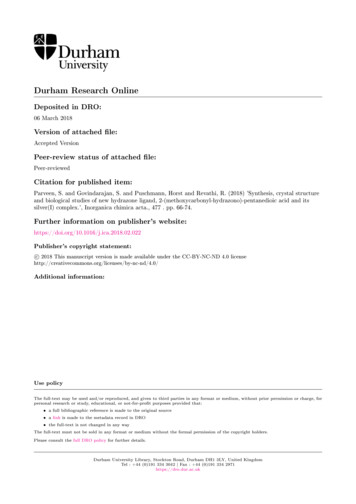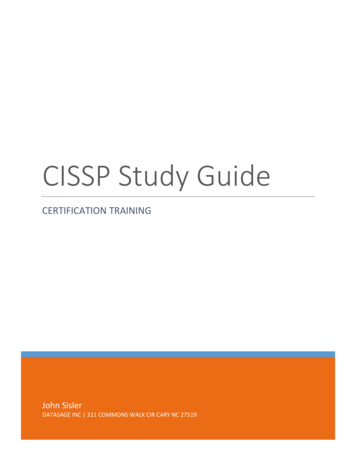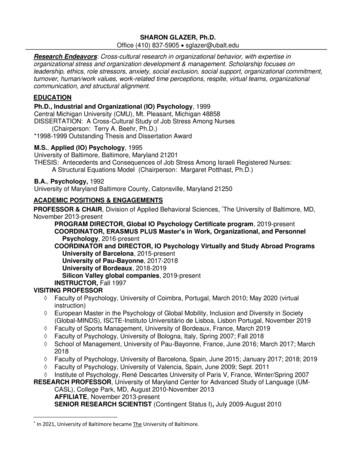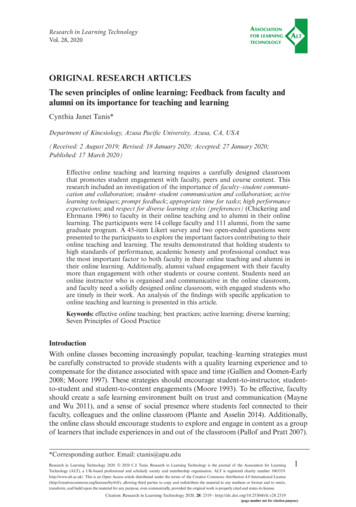
Transcription
Durham Research OnlineDeposited in DRO:06 March 2018Version of attached le:Accepted VersionPeer-review status of attached le:Peer-reviewedCitation for published item:Parveen, S. and Govindarajan, S. and Puschmann, Horst and Revathi, R. (2018) 'Synthesis, crystal structureand biological studies of new hydrazone ligand, 2-(methoxycarbonyl-hydrazono)-pentanedioic acid and itssilver(I) complex.', Inorganica chimica acta., 477 . pp. 66-74.Further information on publisher's ublisher's copyright statement:c 2018 This manuscript version is made available under the CC-BY-NC-ND 4.0 d/4.0/Additional information:Use policyThe full-text may be used and/or reproduced, and given to third parties in any format or medium, without prior permission or charge, forpersonal research or study, educational, or not-for-pro t purposes provided that: a full bibliographic reference is made to the original source a link is made to the metadata record in DRO the full-text is not changed in any wayThe full-text must not be sold in any format or medium without the formal permission of the copyright holders.Please consult the full DRO policy for further details.Durham University Library, Stockton Road, Durham DH1 3LY, United KingdomTel : 44 (0)191 334 3042 Fax : 44 (0)191 334 2971https://dro.dur.ac.uk
Accepted ManuscriptResearch paperSynthesis, Crystal structure and Biological studies of New Hydrazone ligand,2-(Methoxycarbonyl-hydrazono)-pentanedioic acid and its Silver(I) complexS. Parveen, S. Govindarajan, Horst Puschmann, R. s://doi.org/10.1016/j.ica.2018.02.022ICA 18132To appear in:Inorganica Chimica ActaReceived Date:Revised Date:Accepted Date:27 September 201723 January 201817 February 2018Please cite this article as: S. Parveen, S. Govindarajan, H. Puschmann, R. Revathi, Synthesis, Crystal structure andBiological studies of New Hydrazone ligand, 2-(Methoxycarbonyl-hydrazono)-pentanedioic acid and its Silver(I)complex, Inorganica Chimica Acta (2018), doi: https://doi.org/10.1016/j.ica.2018.02.022This is a PDF file of an unedited manuscript that has been accepted for publication. As a service to our customerswe are providing this early version of the manuscript. The manuscript will undergo copyediting, typesetting, andreview of the resulting proof before it is published in its final form. Please note that during the production processerrors may be discovered which could affect the content, and all legal disclaimers that apply to the journal pertain.
Synthesis, Crystal structure and Biological studies of New Hydrazoneligand, 2-(Methoxycarbonyl-hydrazono)-pentanedioic acid and itsSilver(I) complexS.Parveena, S.Govindarajana*, Horst Puschmannb and R.RevathicaDepartment of Chemistry, Bharathiar University, Coimbatore-641046, Tamil Nadu, IndiabDepartment of Chemistry, Durham University DH1 3LE, United KingdomcDepartment of science and Humanities, SRIT, Coimbatore-641010, Tamil Nadu, India*Corresponding author: Email: drsgovind @yahoo.co.inTelephone number: 91 9486036449AbstractA new hydrazone ligand (2-(Methoxycarbonyl-hydrazono)-pentanedioic acid, H2L), derived frommethyl carbazate and α-ketoglutaric acid, and its Ag(I) complex [Ag(HL)(H2L)] weresynthesised and characterised by elemental, spectral and thermal analyses. The X-raystructures of the ligand and complex were determined. The silver ion is hexa-coordinated totwo tridentate (O, N, O) hydrazone ligands in a distorted octahedral environment. Thebinding carboxylic acid group is protonated in one of the ligands (netural) while it is presentas the carboxylate in the other (negatively charged) ligand. The bulk material of the complexthermally decomposes to form metallic silver sheets. The ability to scavenge radical of both,the ligand and complex, was studied against these radicals: DPPH , ABTS , NO and O2.-.The binding affinity and mode of binding towards CT-DNA were recorded by UV-absorptionand the ethidium bromide displacement method. The interaction of ligand and complex withbovine serum albumin was investigated using UV-Vis, fluorescence and synchronousspectroscopic methods. The silver complex showed strong binding propensity than the freeSchiff base ligand in binding studies. The antimicrobial activity was studied against bothbacteria and fungi strains and the silver complex exhibited significant activity as compared tothe ligand alone. Significantly high antimicrobial activity was noticed especially forStaphylococcus aureus, and Escherichia coli which were extensively studied by MIC1
methods. Furthermore, the ligand and complex show potential cytotoxicity towards the MCF7 breast cancer cell line. Both of them have been found to induce apoptosis confirmed byAO/EtBr and DAPI staining assays.Key wordsHydrazones; apoptosis staining; antimicrobial activity; DNA- and BSA- binding.1. IntroductionMetal complexes containing methyl and ethyl carbazates (R-O-CO-NH-NH2, R -CH3, C2H5) have been of considerable interest due to their interesting thermal and structuralproperties [1-9]. Carbazates are interesting as ligands in view of their variety of potentialoxygen and nitrogen donar atoms and these neutral molecules are expected to exhibit onlyone a common coordination mode, namely bidendate N, O- chelation. Apart from itscoordination ability, alkyl carbazates can also undergo condensation reactions; the hydrazinicpart of the terminal amine group reacts with the carbonyl groups of aldehydes or ketones toform Schiff bases. However, Schiff bases and their metal complexes derived from methyl andethyl carbazate have not been studied except our own recent reports [10-13] of Schiff basesderived from analogous benzyl carbazate with alkyl and heteroaryl ketones and their metalcomplexes.The ability of Schiff base complexes to interact with DNA and proteins has attracted muchattention in the search for new chemotherapeutic agents and nucleic acid structural probes[14,15]. Also our recent study [11] has shown that the Schiff base complexes strongly bind toHSA, the essential distributors of metal ions, drugs and various metabolites throughout thehuman body [16]. Therefore, to obtain new pharmaceutically active compound is to combinedifferent pharmacophore groups in the same molecule. In this context, α- Ketoglutaric acid isa naturally occurring ketoacid and an important intermediate in the Krebs cycle, whichgenerates energy for life processes. Further, from the literature survey, it appears that the2
work involving Schiff base complexes derived from α- Ketoglutaric acid and hydrazinederivatives was the reports on thiosemicarbazide [17] and substituted thiosemicarbazide [18].Against this background we have examined the synthesis and characterisation of silver(I)complex of Schiff base ligand derived from methyl carbazate and α- Ketoglutaric acid, andstudied their chemical and biological behaviour. Metal-based drugs exhibit more cytotoxicactivity against cancer cells than their corresponding ligands. The present study describes theantimicrobial and cytotoxic activity of this silver (I) complex. The antioxidant activity andbinding studies towards DNA, BSA have also been carried out and discussed herein.2. Experimental2.1. Material and methodsAll reagents and chemicals used were of Analytical reagent grade (A.R) and of highestpurity. Doubly distilled water was used as a solvent in all preparations and experiments. Calfthymus CT-DNA, Tris–Tris(hydroxymethyl)methylamine, Ethidium bromide (EB),werepurchased from sigma. The stock solution of CT-DNA was prepared in 5 mM Tris HCl/50mM NaCl at pH 7.2 and the ratio of absorbance at 260 & 280 nm above 1.8:1 indicating thatthe CT-DNA preparation was free from protein contaminations [19]. BSA stock was preparedby dissolving the BSA in 50 mM phosphate buffer at pH 7.4. All stock solutions were storedat 4 C and used within two days. The Human breast cancer and normal breast epithelial cellswere purchased from the National Centre for Cell Sciences (NCCS), Pune, India.Elemental analysis for C, H, and N were performed on a Vario-ELIII elemental analyser.The IR spectra were recorded on a JASCO- 4100 spectrophotometer as KBr pellets in therange of 4000-400 cm-1. Simultaneous TG-DTA studies were done on a Perkin – Elmer PyrisDiamond thermal analyser and the curves obtained in air using platinum cups as holders with3 mg of the samples at the heating rate of 10 C/min. Absorption spectral analysis wereperformed using JASCO V-630 UV-Visible spectrophotometer with quartz cuvettes of path3
length 1cm. NMR spectra were recorded on a Breuker Avance III spectrometer operating at400MHz for 1H and 100 MHz for 13C. 1H/13C NMR chemical shifts are reported in ppm andtetramethyl silane (TMS) used as an internal reference.Crystal data were collected using a Xcalibur, Sapphire3 diffractometer (MITIGEN holderin perfluoroether oil) equipped with an Oxford Cryosystems 700 Plus Series low-temperatureapparatus operating at T 120(2)K. Data were measured ω scans of 1.0 per frame for 6.0 susing MoKα radiation (Enhanced (Mo) X-ray Source, 50 kV, 35 mA). The total number ofruns and images was based on the strategy calculation from the program CrysAlisPro(Agilent) [20]. Actually achieved resolution was Θ 26.498(Ag) 32.844(L). Data reductionwas performed using the CrysAlisPro (Agilent) software which corrects for Lorentzpolarisation. The absorption coefficient (µ) of the ligand and complex are 0.139 & 1.134 andthe minimum and maximum transmissions are 0.904 and 0.981 & 0.738 and 0.886respectively. Using Olex2 the structure was solved with the olex2.solve structure solutionprogram, in the Charge Flipping solution method [21,22]. The model was refined withversion of SHELXL using Least Squares minimisation [23]. All non-hydrogen atoms wererefined anisotropically. Hydrogen atom positions were calculated geometrically and refinedusing the riding model.2.2. SynthesisH2L: Alpha ketoglutaric acid (0.146 g, 1 mmol) and methyl carbazate (0.092 g, 1 mmol)were dissolved in 20 mL of doubly distilled water and heated on a water bath for 4 h. Theresulting clear solution was allowed to crystallize at room temperature. Block shapedcolourless crystals formed after three days, were filtered off, washed with cold waterfollowed by ethanol and air dried. Yield: 95%, Elemental analysis found: C, 35.68%; H,5.20%; N, 11.58%. C7H12N2O7: Calc. C , 35.59%; H, 5.12%; N, 11.86%. UV-Vis (10 -3 M,λmax, nm (ε [M-1cm-1])): 240 (20450), 289 (17500). FT-IR (KBr, cm-1): 3607, 3476 (OH),3214 (NH), 1739 (C O), 1602 (C N), 1048 (N-N). 1H NMR (400 MHz, DMSO-d6, δ, ppm):4
10.73(s, NH), 3.73(s, OCH3), 3.71(s, H2O), 2.69-2.65(t, 7.4 Hz, CH2), 2.38-2.34 (t, 7.6 Hz,CH2). 13C NMR (100 MHz, DMSO-d6): 173.48 (C7), 165.38 (C1), 154.09 (C3), 143.52 (C2),52.41 (C4), 29.66 (C6), 21.06(C5).[Ag(HL)(H2L)]: To a hot aqueous solution (20 mL) of ligand (0.472 g, 2 mmol), 0.170 g ofsilver nitrate (1 mmol) dissolved in 20 mL of water was added in drops with continuousstirring, over water bath to prevent precipitation. Careful addition of aqueous solution of 3-4drops of triethylamine was made to facilitate complexation. The resulting solution onevaporation at ambient condition resulted polycrystalline solid which was separated asbefore. The compound was stored in dark at all times. Glossy white crystals suitable fordiffraction studies were obtained only at fifth time of crystallisation. Yield: 88%. Elementalanalysis found: C, 30.70%; H, 3.01%; N, 10.41%. Ag, 19.70%; C14H19AgN4O12: Calc. C ,30.95%; H, 3.52%; N, 10.31%; Ag, 19.85%. UV-Vis (10-3 M, λmax, nm (ε [M-1cm-1])): 242(24800), 293 (18600). FT-IR (KBr, cm-1): 3420 (OH), 3209 (NH), 1724 (C O), 1585 (C N)1545, 1266 (COO-), 1056 (N-N). 1H NMR (400 MHz, DMSO-d6, δ, ppm): 8.30(s, NH), 3.74(s, OCH3), 3.65 (s, OCH3), 2.74-2.70 (t, 7.8 Hz, CH2), 2.60-2.57(t, 7.4 Hz, CH2), 2.47-2.42 (t,7.4 Hz, CH2), 2.39-2.35 (t, 7.6Hz, CH2).13C NMR (100 MHz, DMSO-d6):173.87 (C7),165.31 (C1), 79.10 (C3 & C2), 52.45 (C4), 29.74 (C6), 21.26 (C5).2.3. DNA binding studiesLigand and complex were first dissolved in DMSO to give 1 mM stock solutions,which further diluted in 5 mM Tris HCl/50 mM NaCl buffer at pH 7.2. Electronic absorptionspectra were recorded in the range of 200-500 nm by increasing concentration of CT-DNA(30 µM) to the complex (50 µM). The solution mixture was kept for 10 min at equilibriumbefore recording spectrum. Competitive EB binding study was performed in order toinvestigate that compounds could replace EB from EB-DNA system by fluorescencespectroscopic titration. The fluorescence emission spectra were recorded in the wavelengthrange of 530-700 nm, with excitation wavelength at 525 nm after successive addition of5
compounds to a solution containing 8 µM EB and 10 µM CT-DNA.2.4. Albumin binding studiesBinding studies with protein by tryptophan fluorescence quenching experiments wereperformed using Bovine Serum Albumin (BSA) as a model protein. Like DNA bindingstudies, compound’s stock solutions were prepared by using 50 mM phosphate buffer insteadof Tris HCl buffer. A 3 mL solution containing appropriate concentration of BSA (5 µM) wastitrated by successive additions of 5 µL stock solution of compounds (0-40 µM).Simultaneously, synchronous fluorescence spectra of the mixture were recorded in the rangeof 270-400 nm by setting λ 15 nm and λ 60 nm (difference between the excitation andemission wavelengths of BSA) for tyrosine and tryptophan residues respectively. UVabsorption spectra of BSA were recorded in phosphate buffer in the absence and presence ofincreasing concentration of compounds.2.5. Antioxidant assaysIn vitro radical scavenging assays were performed in triplicate and standard deviation ofabsorbance was less than 10% of the mean. Ascorbic acid (AA) and butylated hydroxylanisole (BHA) are used as positive control in all assays. 1,1-diph
*Corresponding author: Email: drsgovind @yahoo.co.in Telephone number: 91 9486036449 Abstract A . The stock solution of CT-DNA was prepared in 5 mM Tris HCl/50 mM NaCl at pH 7.2 and the ratio of absorbance at 260 & 280 nm above 1.8:1 indicating that the CT-DNA preparation was free from protein contaminations [19]. BSA stock was prepared by dissolving the BSA in 50 mM phosphate buffer at pH .











